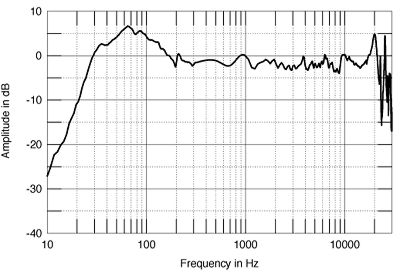| Columns Retired Columns & Blogs |
JMlab Mezzo Utopia loudspeaker Measurements
Sidebar 3: Measurements
My estimate of the Mezzo Utopia's B-weighted sensitivity was slightly lower than specified, at 90dB(B)/2.83V/m, but this is still high. While the Mezzo's impedance magnitude (fig.1) dropped to 3.4 ohms in the upper bass, combined with a nasty capacitive phase angle in this region, it remained above 4 ohms above 200Hz; the speaker will be relatively easy to drive if you don't play bass-heavy music. Trip-hop fans had better use a good high-current amplifier. The saddle in the impedance magnitude at 29Hz is the tuning frequency of the large-diameter port and suggests excellent LF extension.

Fig.1 JMlab Mezzo Utopia, electrical impedance (solid) and phase (dashed). (2 ohms/vertical div.)
The wrinkles in the impedance traces between 20kHz and 30kHz are due to the tweeter's ultrasonic resonances, which will be benign. However, the sharp discontinuity in the traces at 200Hz suggests the presence of a serious cabinet resonance at this frequency. Still, investigating the cabinet panels' resonant behavior with an accelerometer revealed that the only significant mode lay at 360Hz, and that although this was detectable on all surfaces, it was actually quite well down in level (fig.2).

Fig.2 JMlab Mezzo Utopia, cumulative spectral-decay plot of accelerometer output fastened to side wall 12" from base. (MLS driving voltage to speaker, 7.55V; measurement bandwidth, 2kHz.)
The 200Hz mode must therefore be an internal acoustic or airspace resonance. This can be seen in the very sharp discontinuity in what should be the smooth curve of the woofer's nearfield response (fig.3). It is difficult to predict the subjective effect of this problem, but I would have expected it to add some chestiness to male spoken voice and to obscure low-frequency transparency. I note that PM was bothered by both a lack of textural clarity in the bass and some energy storage problems. The other traces in fig.3 show the nearfield output of the midrange unit (right), which rolls off gently below 400Hz, though with a -20dB shelf in that rolloff for a couple of octaves. The sharp minimum in the woofer's output at 29Hz coincides nicely with the electrical tuning of the port (fig.1), and the port's output (left trace) covers quite a broad bandpass: from below 20Hz to 100Hz.

Fig.3 JMlab Mezzo Utopia, nearfield midrange, woofer, and port responses..
Fig.4 splices the complex sum of the nearfield woofer, midrange, and port responses to the anechoic farfield response, averaged across a 30 degrees lateral window on the tweeter axis. From the lower midrange up, the Mezzo's response is superbly flat and even, broken only by a slight peak at 1kHz and the tweeter's inconsequential ultrasonic misbehavior. A number of minor ripples in the treble are due to early reflections from the wide baffle. While these amplitude-domain ripples will not be heard as colorations, the reflections that cause them might slightly interfere with imaging specificity. Note that fig.4 indicates that the Mezzo's bass region is lifted by around 6dB. This will be partially due to the nearfield measurement technique, which assumes a 2pi environment. But as PM did comment on the Mezzo Utopia's generous bass balance even when the speakers were placed well out in the listening room (the closest thing to a 4pi environment), this graph indeed tells it like it is.

Fig.4 JMlab Mezzo Utopia, anechoic response on tweeter axis at 50", averaged across 30 degrees horizontal window and corrected for microphone response, with the complex sum of the nearfield midrange, woofer, and port responses plotted below 300Hz.
Other than a residual flare at the base of the tweeter's passband, which will add a slight brightness in very lively rooms, the Mezzo Utopia's horizontal dispersion (fig.5) is superbly well controlled, the speaker's output falling off smoothly to its sides. It may be physically large, but the JMlab behaves more like a minimonitor in this respect. In the vertical plane (fig.6), the speaker's balance doesn't change significantly over a 30"-42" range of listener ear heights. Above and below that sensible range, a suckout appears at the upper crossover frequency.

Fig.5 JMlab Mezzo Utopia, lateral response family at 50", normalized to response on tweeter axis, from back to front: differences in response 90 degrees-5 degrees off-axis, reference response, differences in response 5 degrees-90 degrees off-axis.

Fig.6 JMlab Mezzo Utopia, vertical response family at 50", from back to front: differences in response 20 degrees-5 degrees above HF axis, reference response, differences in response 5 degrees-10 degrees below HF axis.
In the time domain, the Mezzo's step response (fig.7) indicates that all three drive-units are connected with positive acoustic polarity, but that the speaker is not time-aligned, despite its slanted midrange and woofer baffles. The cumulative spectral-decay plot (fig.8) is not as clean in the treble as I would have liked, but what might be thought to be ridges of delayed energy due to resonances are actually the results of the early reflections mentioned above.

Fig.7 JMlab Mezzo Utopia, step response on tweeter axis at 50" (5ms time window, 30kHz bandwidth).

Fig.8 JMlab Mezzo Utopia, cumulative spectral-decay plot at 50" (0.15ms risetime).
Other than its bass balance, which will be a matter of personal taste, the JMlab Mezzo Utopia measures as well as it sounds.—John Atkinson
- Log in or register to post comments




































